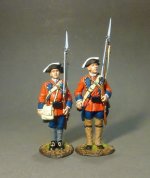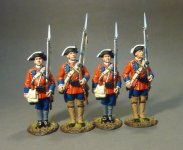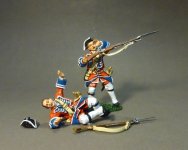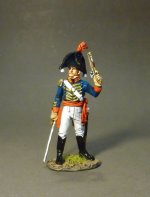THE EIGHTEENTH CENTURY
THE RAID ON ST. FRANCIS 1959
The 60th (Royal American) Regiment of Foot, better known under its later name, The King's Royal Rifle Corps, has long been associated with Canada. After Braddock's defeat by the French and Indians in 1755, authority was granted to raise a regiment of four battalions to be recruited in Germany and from German colonists in North America. The regiment was named the 62nd, or Royal American, Regiment of Foot; but it was re-designated the 60th (Royal American) Regiment of Foot in February 1757. Recruiting for the Royal Americans in North America was disappointing, and more than half its strength was drafted from men rejected by British regiments in Ireland. From this unlikely collection of foreigners and cast-offs was fashioned one of the most renowned corps of the British Army.

RRB60-06
THE RAID ON ST. FRANCIS 1759, 60th (ROYAL AMERICAN), REGIMENT OF FOOT,
2 Line Infantry At Attention,
(2pcs)

RRB60-06N
THE RAID ON ST. FRANCIS 1759, 60th (ROYAL AMERICAN), REGIMENT OF FOOT,
4 Line Infantry At Attention, Set #1,
(4pcs)
THE JACOBITE REBELLION 1745
Barrell's was on the left of the front line. The fighting opened with an exchange of artillery fire which prompted the highlanders to start running towards the British lines so that they were not standing targets. They fell upon the British left so that Barrell's (and Munro's 37th) took the brunt of the charge. The Scots ranks were severely thinned out as they ran forward, by grapeshot and at least two volleys from Barrell's and Munro's. The Scots had discarded their muskets and were now armed with pistols, swords and shields.
There is no doubt that Barrell's regiment did most of the fighting that day. The men fixed bayonets and were ordered to lunge at the Highlander on their right rather than the man approaching their front. In this way they were able to strike a blow behind their shields rather than having a bayonet stuck in the shield. The casualty figures show how bravely they fought before being forced back. 17 killed and 108 wounded, by far the greatest number out of all the regiments.

BJ-14
THE JACOBITE REBELLION 1745
4th Regiment of Foot (Barrell’s)
2 British Line Infantry Casualties,
(4pcs)
Limited Edition 500
THE WAR OF 1812
This period was full of activity for the Marines. Starting with the fights with the Barbary corsairs, and continuing throughout the War of 1812. The Marines were to take part in virtually every action at sea, on the Great Lakes, and also in many engagements on land. A section of the line at New Orleans were held by the Marines at this battle. Therefore they were extremely active despite the strength of the corps only averaging about 1,000 officers and men.

1812M-01
THE WAR OF 1812
U.S. MARINE CORPS, 1814, MARINE OFFICER,
(1pc)
**PLEASE CONTACT YOUR LOCAL DEALER FOR MORE INFORMATION**
THE RAID ON ST. FRANCIS 1959
The 60th (Royal American) Regiment of Foot, better known under its later name, The King's Royal Rifle Corps, has long been associated with Canada. After Braddock's defeat by the French and Indians in 1755, authority was granted to raise a regiment of four battalions to be recruited in Germany and from German colonists in North America. The regiment was named the 62nd, or Royal American, Regiment of Foot; but it was re-designated the 60th (Royal American) Regiment of Foot in February 1757. Recruiting for the Royal Americans in North America was disappointing, and more than half its strength was drafted from men rejected by British regiments in Ireland. From this unlikely collection of foreigners and cast-offs was fashioned one of the most renowned corps of the British Army.

RRB60-06
THE RAID ON ST. FRANCIS 1759, 60th (ROYAL AMERICAN), REGIMENT OF FOOT,
2 Line Infantry At Attention,
(2pcs)

RRB60-06N
THE RAID ON ST. FRANCIS 1759, 60th (ROYAL AMERICAN), REGIMENT OF FOOT,
4 Line Infantry At Attention, Set #1,
(4pcs)
THE JACOBITE REBELLION 1745
Barrell's was on the left of the front line. The fighting opened with an exchange of artillery fire which prompted the highlanders to start running towards the British lines so that they were not standing targets. They fell upon the British left so that Barrell's (and Munro's 37th) took the brunt of the charge. The Scots ranks were severely thinned out as they ran forward, by grapeshot and at least two volleys from Barrell's and Munro's. The Scots had discarded their muskets and were now armed with pistols, swords and shields.
There is no doubt that Barrell's regiment did most of the fighting that day. The men fixed bayonets and were ordered to lunge at the Highlander on their right rather than the man approaching their front. In this way they were able to strike a blow behind their shields rather than having a bayonet stuck in the shield. The casualty figures show how bravely they fought before being forced back. 17 killed and 108 wounded, by far the greatest number out of all the regiments.

BJ-14
THE JACOBITE REBELLION 1745
4th Regiment of Foot (Barrell’s)
2 British Line Infantry Casualties,
(4pcs)
Limited Edition 500
THE WAR OF 1812
This period was full of activity for the Marines. Starting with the fights with the Barbary corsairs, and continuing throughout the War of 1812. The Marines were to take part in virtually every action at sea, on the Great Lakes, and also in many engagements on land. A section of the line at New Orleans were held by the Marines at this battle. Therefore they were extremely active despite the strength of the corps only averaging about 1,000 officers and men.

1812M-01
THE WAR OF 1812
U.S. MARINE CORPS, 1814, MARINE OFFICER,
(1pc)
**PLEASE CONTACT YOUR LOCAL DEALER FOR MORE INFORMATION**

